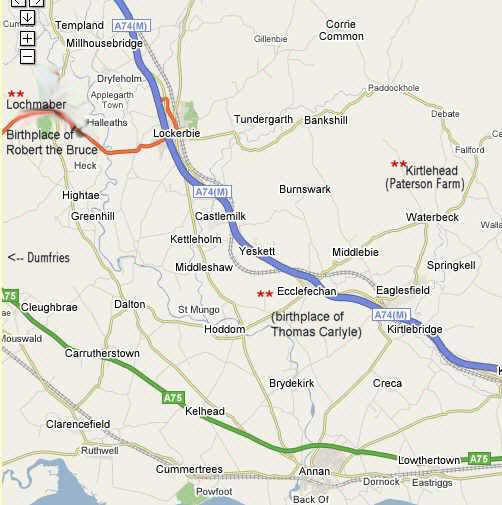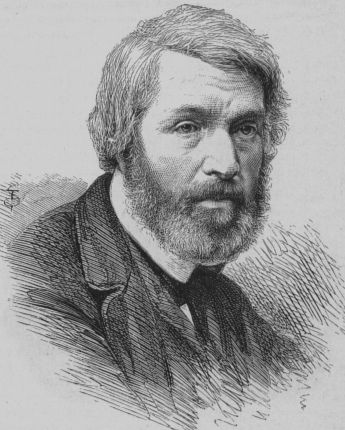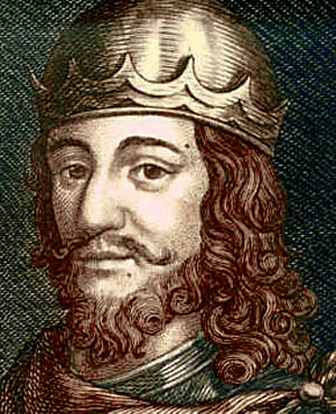A Rich Seam - the Scottish Borders
I worked for a year in
the USA, (1954-55), initially on a farm of a distant relative, Dale
Hartman, of Hoddom Farm,
Wheatland,
Illinois

The farm was named after the area
and castle near the Pat(t)erson country in
Scotland.
A massive emigration of Patersons took place to
Illinois
in the early 1800s.
Hoddom
Castle is now used as a camp site and is associated with a 9
hole golf
course.
Why a rich seam
? While investigating the history of
Hoddom I came across the following interesting facts.
1)
Robert the Bruce, the great, great,
great
grandson of King David 1st of Scotland, was born
at
Lochmaber,
four miles west of Lockerbie.
2)
William Paterson, the founder of the Bank of England was also born
near Lochmaber.
3) Thomas Carlyle, famous mathematician
and writer was born at Ecclefechan, a mile or two from Kirtlehead and was
a friend of the Paterson
family.
4) St Mungo established a monastery
at Mungo in Hoddom. He became a bishop and founded
Glasgow,
of which he is the Patron Saint. One of the early Patterson settlers in Illinois
was called Mungo and there was still a Mungo Patterson there when
I lived there, who I met a couple of times.
The map shows the area in
Dumfriesshire from which the
Patersons
emigrated. The original farm is still situated at Kirtlehead
(marked)

It was the Carlyle
family which built the original
Hoddom
Castle.
After the Norman Conquest of England (1066) the family had been invited
over from
Normandy
by King David I of Scotland
in the name of De Karliolo. This family was settled
in Hoddom ( de
Hodelm)
and Robert de
Karliolo who was born there in 1139
No history of Hoddom would be complete without the mention of
Irvings..
The chief of the
Irving clan
had his tower at Bonshaw on the banks of the
Kirtle and they steadily built up their lands in that district.
By the fifteenth century they had expanded into Hoddom and became a separate
branch of the clan under their own recognised leader. They absorbed much
of the Hoddom lands of the
Carlyles,
who were falling on bad times. In 1420, Archibald, Earl of Douglas, joined
the Scottish Legion in
France,
with a force composed entirely of Borderers. Among this force were the Hoddom
Irvings,
and their leader was known as le Duc, signifying
leader but not regarded as a title, but for 200 years it was applied to the
head of the Hoddom Irvings. This accounts for such
local names as Duke’s Wood, Duke’s Pool on the Annan. Other
Irving holdings
were at Pennersax,
Whitehill, Luce and across
the river at Turnshaw and
Trailtrow. The lrvings
of Trailtrow had the duty of maintaining the fire
on Beacon Hill, before
Repentance
Tower was built, and
for this duty they were given the adjacent farm of Ward Park. In 1552
Rychie Irwin, called Duke, was sworn to "defend
the Kynges Majestie"
and had 127 men. The total clan strength then was 431.
John
Maxwell owned the castle during the 1500s and when he died in 1582 and the
castle passed to his son, then from father to son till about 1627, when the
last Lord Herries, John Maxwell’s great grandson, sold it to Sir Richard
Murray of Cockpool. This family of
Murray was
afterwards created Earls of Annandale and the castle said to be owned by
John, Earl of Annandale
in 1637. His son James married a Carnegie of
Southesk and conveyed the estate of Hoddom to David,
Earl of Southesk about the year 1653. The
Southesk family sold the castle and Barony of Hoddom
to Mr. John Sharpe in 1690. In 1832 a General Sharpe added a wing to the
design of a Mr. Burns and after the purchase of the property by Mr. Brook
of Huddersfield in 1877, another wing was added. These 19th century additions
have mercifully disappeared. The castle was occupied by the army during the
Second World War and has been unoccupied since then, except for its use in
connection with the camp site. The toilets in the castle
are something special !
Other
notables from the
area: (Information from Wikipedia ) Click
on the links:
Thomas
Carlyle
 was
born in
Ecclefechan,
Dumfries and Galloway, and was educated at
Annan Academy He was influenced by his family's (and his
nation's) strong
Calvinism. After attending the
University of Edinburgh, Carlyle became a
mathematics
teacher, first in Annan and then in
Kirkcaldy,
where Carlyle became close friends with the mystic,
Edward
Irving. In
1819
-
1821 he lived
much of his life at
Craigenputtock, a beautiful house
in
Dumfriesshire,
where he wrote many of his works. He often wrote about his life at
Craigenputtock, "It is certain that for living
and thinking I have never since found in the world a place so
favourable.... How blessed, might poor mortals
be in the straitest circumstances if their wisdom
and fidelity to heaven and to one another were adequately
great!" It was the Carlyle family
that had, many years before built
Hoddom
Castle.
was
born in
Ecclefechan,
Dumfries and Galloway, and was educated at
Annan Academy He was influenced by his family's (and his
nation's) strong
Calvinism. After attending the
University of Edinburgh, Carlyle became a
mathematics
teacher, first in Annan and then in
Kirkcaldy,
where Carlyle became close friends with the mystic,
Edward
Irving. In
1819
-
1821 he lived
much of his life at
Craigenputtock, a beautiful house
in
Dumfriesshire,
where he wrote many of his works. He often wrote about his life at
Craigenputtock, "It is certain that for living
and thinking I have never since found in the world a place so
favourable.... How blessed, might poor mortals
be in the straitest circumstances if their wisdom
and fidelity to heaven and to one another were adequately
great!" It was the Carlyle family
that had, many years before built
Hoddom
Castle.
Robert I de
Brus (Robert the Bruce)
11
July
1274 –
7
June
1329

was King of Scots from 1306 to his death in
1329 . He was
probably born at Lochmaber, a small town
in
Scotland, four miles west of
Lockerbie,
in
Dumfries and
Galloway.
His
mother was by all accounts a formidable woman who, legend would have it,
kept Robert Bruce's father captive until he agreed to marriage! From his
mother he inherited the Gaelic
Earldom
of
Carrick, and through his father a royal lineage
that would give him a claim to the Scottish throne. Although his date of
birth is definitely known, his place of birth is less certain: it was either
Turnberry
Castle in
Ayrshire,
or
Lochmaber
in
Dumfriesshire.
Although his paternal ancestors were of
Scoto-Norman
heritage (originating in Brieux, Normandy), his maternal ancestors were
Scottish-Gaels,
and he became one of Scotland's greatest kings, as well as one of the most
famous warriors of his generation, eventually leading Scotland during the
Wars of Scottish Independence against
England. He claimed the Scottish throne as a great-great-great-great grandson
of
David I of Scotland.
His body is buried in
Dunfermline
Abbey, while his heart is buried in
Melrose
Abbey. His heart was to be taken on crusade to the Holy Land as
a penance for the murder of a competitor for the throne of Scotland but only
reached Moorish Grenada. The heart was brought back to Scotland and was buried
in a casket at Melrose Abbey, according to his wishes. It was was found and
reburied quite recently. The film "Braveheart" was
about a different Scottish patriot, William Wallace, of the same era.
As
early as 1160, the Anglo-Norman de Brus (Bruce)
family, had become the Lords of Annandale. Robert
de Bruce, Lord of Skelton in Yorkshire (some references say Cleveland), was
a notable figure at the court of King
Henry
I, where he became a close friend of
Prince David of Scotland, that monarch's brother-in-law. When the Prince
became King of Scots, in 1124, Bruce obtained from him the Lordship of Annandale,
and great possessions in the south of
Scotland.
(de Brus was nevertheless buried at Gysburn, the place of his
birth)
Sir William
Paterson. is not KNOWN to be a relative but was born in 1658 just 'down
the road' from 'our' area, in the same village, Lochmaben, in which
Robert the Bruce was reputedly born. His early travels in the Caribbean
as a young merchant instilled in him an entrepreneurial zeal. It also
enabled him to amass a fortune, which he invested in Dutch banks.
He was an exponent of free trade decades before Adam Smith rewrote modern
economics with The Wealth of Nations. He wrote "Trade will increase
trade and money will beget money, and the trading world shall need no more
want work for their hands but will rather want hands for their work".
Though
he was very famous in his time there is just one portrait of Sir William,
which the founder of the Bank of England posed for in 1708, about a decade
before he died. He had an interesting career, and was the
chief architect of a scheme to establish an independent Scottish community
in Darien (Panama) It turned into a disaster. The immigrants were ill equipped
to cope with a mosquito infested jungle, were harried by the Spanish and
given little support by the English,. The adventure was doomed from the start.
He returned to London 'a broken man'. Nevertheless, he recovered
to play an important part in the 1707 Act of Union with England and was
eventually reimbursed for his massive financial losses. But the financial
rescue of Scotland by England put them under an obligation, from which they
have still to recover !
Robbie
Burns. The famous poet and iconic Scotsman, died in 1796, aged
37. His last years were spent
in a house (now a museum) in Dumfries,
’our’ local city
More on our branch at
http://www.staff.ncl.ac.uk/ian.paterson/index2.htm
Keith Paterson,
Newmarket,
UK, June
2007 (rev 2009)
Site Navigation Links :- Please click on
SITE MAP


 was
born in
Ecclefechan,
Dumfries and Galloway, and was educated at
Annan Academy He was influenced by his family's (and his
nation's) strong
Calvinism. After attending the
University of Edinburgh, Carlyle became a
mathematics
teacher, first in Annan and then in
Kirkcaldy,
where Carlyle became close friends with the mystic,
Edward
Irving. In
1819
-
1821 he lived
much of his life at
Craigenputtock, a beautiful house
in
was
born in
Ecclefechan,
Dumfries and Galloway, and was educated at
Annan Academy He was influenced by his family's (and his
nation's) strong
Calvinism. After attending the
University of Edinburgh, Carlyle became a
mathematics
teacher, first in Annan and then in
Kirkcaldy,
where Carlyle became close friends with the mystic,
Edward
Irving. In
1819
-
1821 he lived
much of his life at
Craigenputtock, a beautiful house
in

![]() Index Page
Index Page![]()